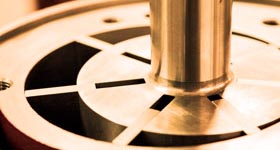Rotary-vane compressors turn up the heat on screw designs
Advances in the technology behind rotary-vane air compressors continues apace. Meaning these machines, rather than screw designs (the conventional market leaders) could be the best compressors to produce your plant’s industrial air.
More energy-efficient compressors
“For a compressor to work efficiently,” says Mattei general manager Andy Jones, “air-leakage paths must be minimised. Air lost during compression equals lost energy; keeping internal leakages low reduces the power required for a measured unit of delivered air.”
Browse Mattei compressors>Near-perfect air seal
- In vane compressors, only a thin layer of injected oil separates the vanes, moving freely in their slots, from the stator’s internal surface. This makes for a near-perfect air seal. Clearances between the rotor, stator and end covers are also efficiently sealed by the oil.
- By contrast, screw compressors have 'blow holes' where the rotors’ external profiles meet. The air under high pressure returns to the area of lower pressure through this hole. To compensate for these air-leakage paths, screw compressors need to run at high speeds. Reliance on accelerating gears or belt transmissions diminishes their fuel efficiency.
More volume, lower speeds
Free of rotary machines’ air-leakage issues, vane compressors are more volumetrically efficient. “In addition,” says Andy Jones, “vane compressors have always operated at low speeds, from a direct drive coupling, which in turn leads to lower power consumption. Some of Mattei's fixed-speed compressors operate at 1,000rpm, whereas the average screw compressor needs to work at 3,000rpm to achieve the same result.”
Lower off-load pressures
Vane-compressor efficiency continues to improve – essential given that the energy needed to produce a given flow of air at a certain pressure is the most important measure of any compressor’s performance. Previously, vane compressors’ off-load energy consumption was considered too high. But today – through improvements in internal lubrication – Mattei is able to reduce its machines’ off-load operating pressure, significantly improving off-load energy efficiency.
Negligible wear
“Another important factor to consider is compressor wear and maintenance,” says Andy Jones. “Many think that the sliding vanes used in a vane compressor will deteriorate and need changing regularly. But in fact, the lubricating oil forms a film on which the vanes slide. With no direct metal-to-metal contact between the vanes and the internal stator wall there’s only negligible wear.”
Long, inexpensive operating lives
Crucially, rotary-vane compressors don’t require the roller bearings used in screw compressors, which manufacturers recommend are replaced as often as every 24,000 hours. Instead, these machines’ rotor shafts are supported by simple white bearings, ensuring long, inexpensive operating lives. Air ends in rotary-vane compressors can easily run for 100,000 hours without wear. In fact, some Mattei machines last more than 230,000 hours in the most arduous operating conditions.
Constantly efficient; streamlined design
Moreover, there’s no wear in a vane compressor’s air end. So the unit’s efficiency stays constant throughout its operating life, whereas a screw compressor's efficiency falls away over time.Versus screw compressors, vane compressors also have fewer parts. Andy Jones says: “There are no gear trains or drive belts that could need replacing; and there aren’t so many hydraulic hoses, reducing the risk of air leakage and failure. All of this means vane compressors offer lower maintenance costs, greater reliability and guaranteed lifetime performance.”
Better-quality air
Lastly, there’s the issue of oil separation. In Mattei rotary-vane compressors, this process is in several stages and particularly effective. It uses high-quality separator elements, which can last for up to 10,000 hours, ensuring machines with exceptionally low oil-carryover – less than three parts per million is standard – throughout their operating lives. Filtration can further reduce oil content to less than one part per million, meaning Mattei machines can be used where an 'oil-free' compressed air supply is required.
Shifting currents
Screw compressors may currently have large market share. But it many ways vane compressors are their equals or superiors. When it comes to energy efficiency, operating speeds, volumetric efficiency, wear and maintenance, and oil carryover, the currents look to favour vane compressors.
Contact us for more info>
Back to news
